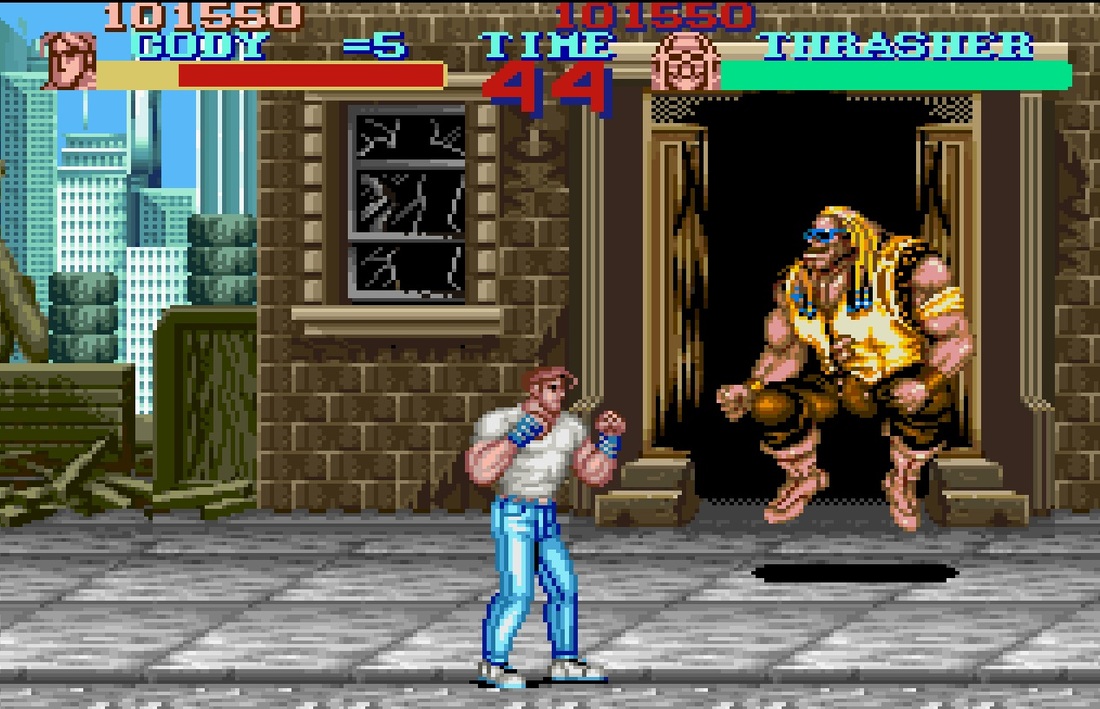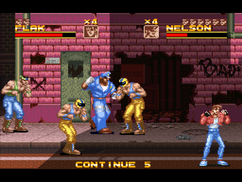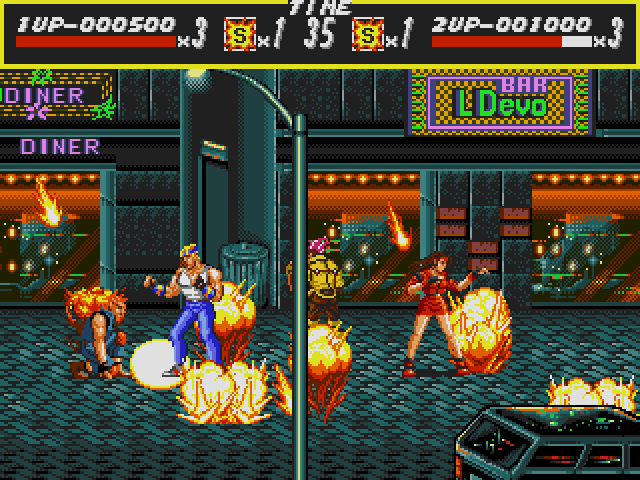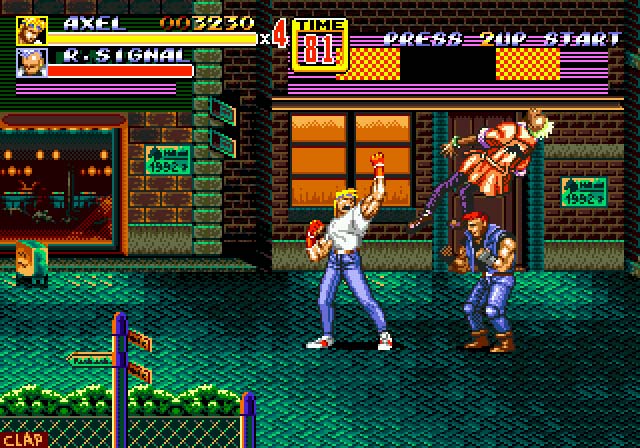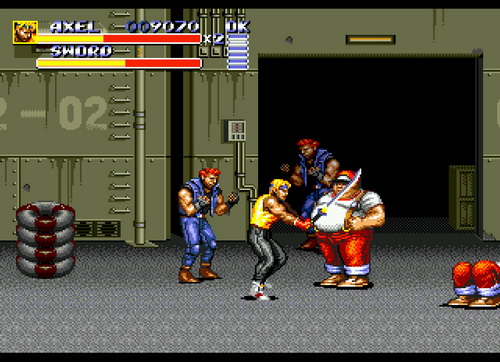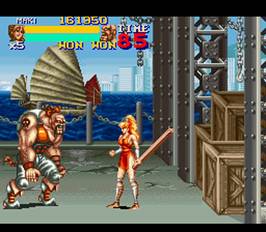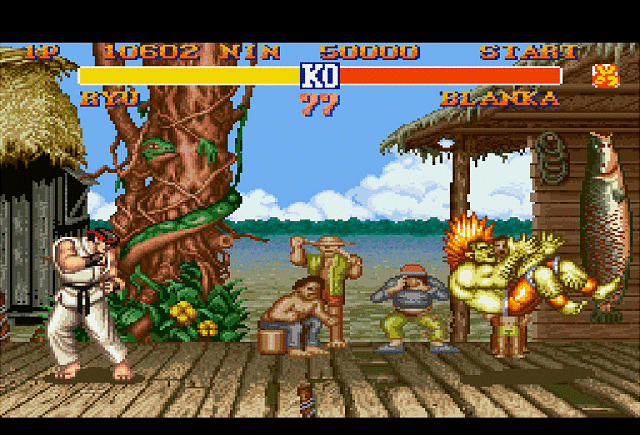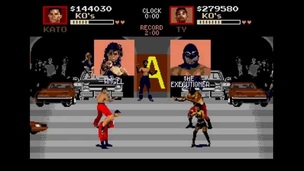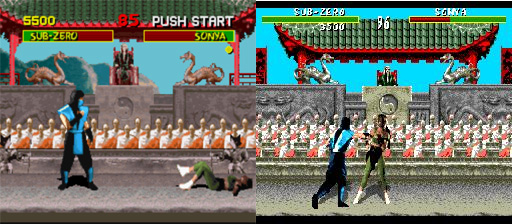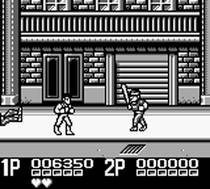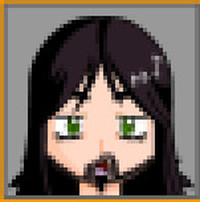Nintendo went straight for the jugular with the Super Famicom and commissioned a port of the superb Final Fight as one of the earliest games for their new machine. The conversion featured the same huge graphics and violent gameplay that the arcade was famous for....for the most part. The trouble was that being a brand new machine AND being one of the first games to appear on the system, it didn't give Capcom a lot of time to get familiar with the hardware. This meant that the programmers didn't know all the coding tricks just yet, and the bad news is that Final Fight SNES suffered some rather harsh losses such as a playable character, one whole level, and the real pube in the soap - the simultaneous two player mode was gone. Or rather, not quite optimised.
The game actually DOES have code in it which supports a two player mode and even a reserved memory address range for the second player on screen. However, I guess they just couldn't figure out how to stop sprite flicker and slowdown thanks to the SNES woefully slow CPU which clocked in a 3.5MHz compared to the Megadrive's Motorola 68000 which few along at double the speed of 7MHz. The two player mode was most likely abandoned at the last minute due to the development time running out, but with the code remaining intact and the game hard wired to a 1 player mode from boot up. Additionally, the game did not use any graphics compression routines, and this fact combined that the largest storage memory size for a super Famicom cartridge at that time was 8 Megabits meant that there was no room for either Guy or the Industrial area stage.
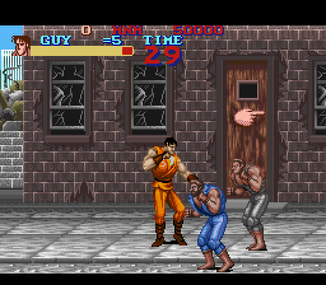 Final Fight Guy was little more than a cash grab
Final Fight Guy was little more than a cash grab Regardless of this, many fans were disappointed that more was not added to Final Fight Guy, such as the industrial level being re-inserted or the two player mode being available, which after 2 years since the original FF SNES's release would have been relatively easy to implement. As such, the game was seen more as a cash grab. Mean Machines ran a small section on the game stating these elements were indeed reinserted but this turned put to be nothing more than hopeful speculation (lies!)
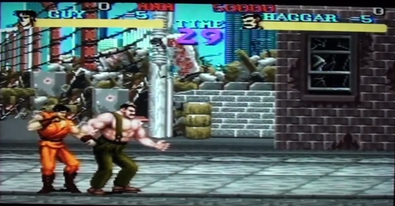 A screen grab of Rotwang's Final Fight ROM hack for SNES which re-instates the two player mode.
A screen grab of Rotwang's Final Fight ROM hack for SNES which re-instates the two player mode. The hack is still a work in progress and not quite perfected yet but it is available and playable all the way through. However, it does not re-instate the Industrial Area level as there were no graphics or tile-maps made for either versions of the SNES ports. Rotwang himself said that it is possible, but it's not something he plans to pursue.
There's not much information out there on either Rotwang himself or this hack. However needless to say, many people who felt slightly cheated at the original port(s) are very interested in seeing the game as it should have been on the Super Nintendo.
The first of these clones was Rival Turf by Jaleco, a game notorious for being the first blatant Final Fight rip off which offered the slight upgrade of a simultaneous two player mode and some absolutely terrible box art in America.
| Rival Turf was universally panned by magazines at the time but in reality is was a fine and solid game that only had a few minor issues with hit detection. The game sported good graphics, sound and gameplay although such an obvious cash grab was bound to ruffle a few feathers. Jaleco followed up Rival Turf with the Rushing Beat series of side scrollers which, while decent enough games, offered little new to the player except more of the same. |
Time passed and Sega owners were incredibly happy with their iconic release, but the fact remained that - amazing though Streets of Rage was, it still wasn't quite as good as Final Fight no matter how you looked at it. The sprites were smaller and less well animated, the moves were basically all the same for each character, and some of the sound effects were dull and lacklustre. This was partly due to the fact that Streets Of Rage was created using the Revenge Of Shinobi engine (possibly for development speed) and you can tell this from the similar HUD and some sound effects that both games share. With that in mind Sega decided to up their game and announced Streets Of Rage 2 this time developed by Yuzo Koshiro's own company Ancient. During development they released some footage of the near completed game on a VHS video given free away with one of the UK magazines at the time. The somewhat fuzzy footage showed what looked like an updated version of the first game with similar looking levels but with undeniably larger sprites and updated sounds. This had whet the appetite for fighting fans just enough to keep them interested until the game was unleashed.
Streets Of Rage 2 was released in December 1992 and almost tipped the scales back to Sega in the console wars. They had taken the concept of the fist game and put the entire thing on steroids, and what came out was an absolute beast. Everything, and I mean EVERYTHING was improved apon. Graphics, sound, gameplay, presentation, the works. The new engine had been written from scratch and it showed. The sprites were massive and had much more variety, the sound effect were much crunchier and way more satisfying compared to the cardboardy thwacks of the first game. New elements had also been added to the gameplay such as multiple special attacks and vertical scrolling - the latter of which was first seen in Sega's own Dynamite Dux in 1988, but used to great effect in Streets of Rage 2.
Much of the praise came from Yuzo Koshiro's magnificent score which surpassed the original game by miles with it's iconic mix of house, jazz and dance with some amazingly catchy melodies. Streets Of Rage 2 without a question of a doubt, had surpassed SNES Final Fight, stood head and shoulder above it and could even give the Final Fight arcade game a run for its money. For a home console that wasn't even new tech anymore, it was a tremendous feat. Sega completed the trilogy with the less than great Streets Of Rage 3 in 1994. The game was little more than Streets Of Rage 2 with a few new moves, and featured grubby graphics, recycled bad guys from the second game, sound effects that only worked 'sometimes' and an innovative but annoying soundtrack. The game was playable enough but didn't really offer anything that new.
Final Fight 2 was released in 1993 to not a roar of success but rather a “Hmmm!” of WTF? Final Fight 2 turned out to really be not much better than any other scrollers on the system at that time. The controls and moves were exactly the same as the first game and no new attacks or techniques had been added to the combat which was a complete waste of the six buttons on the controller. The game even had the cheek to steal the vertical scrolling from Streets Of Rage 2 but didn't really do much with it. Graphically it was still Capcom quality all round, with huge colourful sprites and lush backgrounds that really looked like a proper arcade game. The play was smooth, responsive and fun for the most part, but only one of the two new characters - Maki - was even remotely interesting, and the international setting which took the action out the grimy streets of Metro city just didn't feel right. The sound was also a contrived mix of overly happy music and splatty effects all saturated in typical SNES echo that did the job but never really much more.
| For a game to carry such an important legacy as this one and to have the hindsight of not only it's own legendary heritage but also time to have a good look at the competition, even being a solid game fell far below expectations. A third game was also released as a SNES exclusive in 1995 which featured more updated graphics and new characters and moves, but it was a case of too little too late. The game wasn't quite different enough, the new characters were boring, and at that time all eyes seemed to be on the competition fighters. |
| Home ports of Mortal Kombat and Pit-Fighter appeared on both the Sega and Nintendo machines with some stark differences in both. The Megadrive Pit-Fighter was a graphically cut down version of the arcade game that lost the sprite scaling but actually improved on the arcade with smoother action, a wider viewfield and was an extremely playable beat 'em up. The SNES port in comparison, was dire. Also missing the scaling graphical effects which it so easily could have handled, but with zero attention given to the gameplay. |
| The hand held market fared reasonably well. The Gameboy came out tops with it's excellent versions of Double Dragon 1 & 2, and while not strictly a beat 'em up, the Game Gear hit a home run with the superb GG Shinobi and an ok port of Streets Of Rage. Again clones came and went with ports of SNK arcade games as well as others being licensed for the two big machines. The scrolling beat 'em up market was strong on the consoles and the flood of the new competition fighters were keeping the box kids happy. But what about the 'other' home market? |
| Striding forth from his lair at Castle Stareskull one morning, Prototron decided to not reign down terror on the villagers, but instead go back inside, crack open a beer and load up Streets Of Rage 2. One hundred years later, he's still there. A avid music maker (of TERROR!) and retro gamer, he can be found whooping any and all heroes at all manner of SNK-based challenges. |

